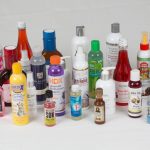Part 2. Mechanical and chemical recycling
Once the sorting has been completed, it becomes essential for further steps to wash the plastic pieces. It is performed with water and caustic or detergents followed by the corresponding drying using compressed air and mechanical action ca. rotor disk, fluidized bed etc. This process may be integrated to the sorting on a conveyor. Waste water is produced that requires treatment.
Mechanical recycling
Actually, this process is the main recycling procedure and covers PE (Polyethylene), PP (Polypropylene) and PET (Polyethylene terephtalate). Its success depends on clean and pure mono stream to be blended with original resin. For instance, PET is generally recycled/downcycled once from bottle to textile. In general, downcycling is the major procedure in mechanical recycling. Furthermore, some drawbacks limit its used: difference in plastic grade, additive contain, other polymers contain, degradation during the reprocess that changes properties as molecular weight and viscosity. Requirements of use ca. food packaging, also restricts recycling. Other uses may also limit the postconsumer recycling and being more flexible to the postindustrial recycling. More sophisticated mechanical procedures as dissolution/ precipitation have also being used. With solvent or supercritical fluid, dissolution-precipitation-antisolvent-precipitation steps have been used1 for cotton-PET mixed fibers and PLA/PET mixtures.
Chemical recycling
Demanding market is strict regarding quality that may be improved by means of chemical recycling. It consists in depolymerization back to the corresponding monomers that can be purified and repolymerized. Two aspects2 must be taking into account in order to decide if it is worth it. Firstly, a thermodynamic aspect must be taking into account. Polymerization is an entropy unfavorable (Sp < 0) process but an enthalpy (Hp < 0) favorable one. Polymers with ( –Hp ) < 70 Kjoule/mol monomer are suitable for depolymerization. The other aspect is the incentive to recover monomers rather than degrading the polymer to hydrocarbons, measured as the amount of consumable used to produce the polymer per amount of carbon in the polymer (t (tons) of consumable/t of C in polymer, tc). The lower this number (easier to make) there is more incentive for depolymerization. Typical polymers with –Hp < 70 and low t/tc ratio are PET and polyamides. In fact PET is conveniently depolymerized3 by solvolysis using methanol to yield dimethyl terephthalate and bishydroxyethyleneterephthalate (BHET) when ethylene glycol is used. Polymers unsuitable to be depolymerized as Polyolefins, may be pyrolyzed to hydrocarbons.
1.- J. Sherwood, M. Johnson, Technol. Rev. (2020), 64, 4−15
2.- J.-P Lange, Green Chem. (2002), 4, 546−550.
3.- V. Sinha,. M. R. Patel, J. V. Patel, J. Polym. Environ. (2010), 18, 8−25.





